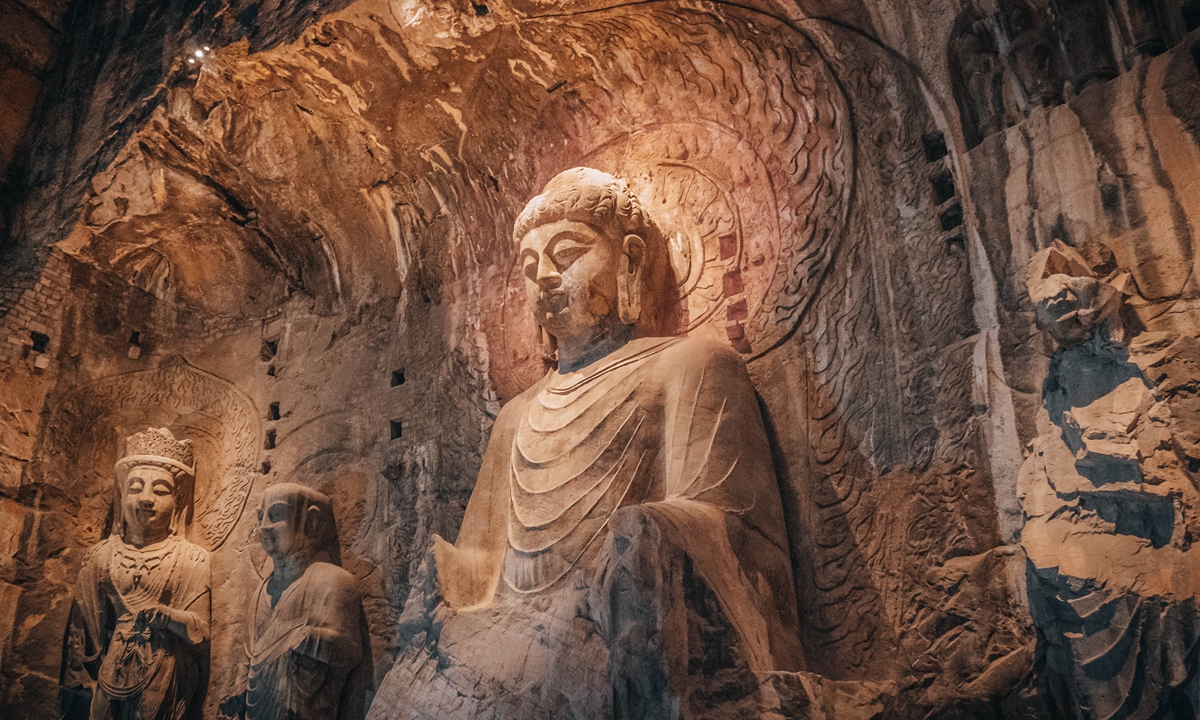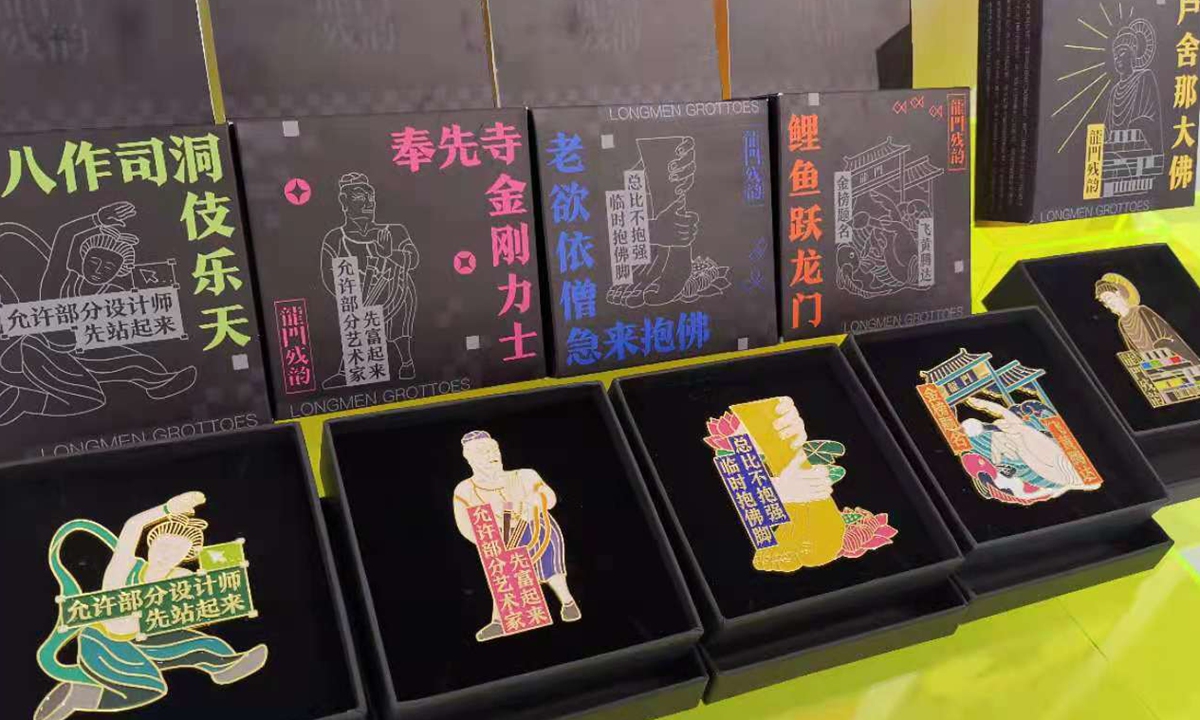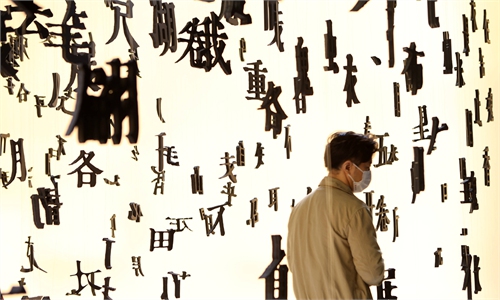ARTS / ART
Tech companies, artists use futuristic means to promote China’s 1,500-year-old Longmen Grottoes
Digital makeover

The Vairocana Buddha statue at Longmen Grottoes Photo: VCG

The Remaining Charm of Longmen brooch collection by Jing Zhihao Photo: Courtesy of Jing Zhihao
Editor's Note:Carrying the genes and spirit of a nation, cultural relics and heritages are irreplaceable resources for a thriving civilization. A huge number of Chinese relics have gotten more popular over the past 10 years and allowed people from around the world to get to know Chinese culture better. The Global Times will feature a number of these "star" artifacts in this series, to make cultural relics stored in museums, heritages displayed throughout the vast land and texts written in ancient books come alive.
As Chinese President Xi Jinping has said, Chinese civilization, together with the colorful civilizations of other countries, should provide mankind with proper spiritual guidance and a strong spiritual impetus.
The Longmen Grottoes in Luoyang, Henan Province, was listed as a UNESCO World Heritage Site in 1971. Over the years, China's State Administration of Cultural Heritage has implemented numerous preservation projects to ensure the time-weathered Northern Wei Dynasty (368-534) treasures are passed on to future generations.
Part of these plans has been digital conservation, which has inspired a new-generation Chinese creative workers to bring the ancient grottoes to people around the world through high-tech means.
With its first artworks built during the Northern Wei Dynasty, the Longmen Grottoes is home to more than 2,300 caves and alcoves filled with art, among which the most famous is the Vairocana Buddha statue. Sporting a delicate smile, it is often called the "Asian Mona Lisa" as it perfectly captures the grottoes' sense of mystery.
The Longmen Grottoes is home to more than 100,000 of these Buddhist statues. However, many have been severely damaged over the past centuries by the elements, as well as other factors such as theft.
To prevent more of this history from disappearing forever, conservation efforts have been carried out over the years.
In 2001, UNESCO initiated a $1.25 million project to preserve the grottoes, with Japan pledging $600,000 to save the world treasure. Such international cooperation has also extended to education as relics from the grottoes have been displayed in countries such as Japan and Belgium.
"However, it is not just about aesthetics, the grottoes embody Chinese beliefs and history, making it a 'cultural window' for Westerners to understand China better," Xiong Gang, a global art researcher, told the Global Times.
In 2021, Ma Chaolong, director of the Conservation Research Center of the Longmen Grottoes Research Institute, and his team began a new project to address severe seepage issues as well as to reinforce the caves.
That same year, as part of China's 14th Five-Year Plan(2020-25), the State Administration of Cultural Heritage published a special plan for the protection and utilization of the grottoes that highlighted "enhanced digital innovation" as a future means of conservation.
These efforts have inspired China's tech industry, leading many companies to help along preservation efforts in their own unique way.
For instance, with the support of government policy, NetEase Games' Leihuo Game Studio recreated the grottoes in virtual reality to transport people back to when the site was full of life.
"Merely depending on touring exhibitions is a thing of the past. With young people around the globe accepting virtual art and the virtual economy, the culture of the Longmen Grottoes can travel around the world even more quickly through futuristic creativity," Xiong noted.
Longmen charm
Another artist who has been inspired by these efforts is Jing Zhihao, a graduate from the Sichuan Fine Arts Institute in Chongqing Municipality, who spent four years working on his creative design project called The Remaining Charm of Longmen.
Jing's project is unlike other digital restoration projects that attempt to recover the Longmen Grottoes' original appearance. Instead, the cutting-edge project focuses on giving the site's blemished cultural relics a new look using dynamic digital graphic techniques.
"I'm not a historian. I use visual language to pique people's curiosity about history," Jing said.
For instance, Jing gave the grottoes' well-known Vairocana Buddha, a Tang Dynasty (618-907) statue modeled on China's first and only female emperor Wu Zetian, a radical makeover by removing both of its hands.
In place of the hands, the designer added a multicolored test pattern that one often sees when a TV loses its signal, thus giving this ancient relic a trendy and surreal look.
"The pattern stands for infinite imagination and a sense of longing for history," Jing explained.
Jing has also launched cultural products such as stationary, reed diffusers and accessories to bring the grottoes closer to people's lives.
His surreal Vairocana Buddha has been turned into a brooch, as have other relics such as a Buddha foot and a Vajra statue from the grottoes' fascinating Fengxian Temple. They have been adorned with interesting slogans, such as "better to hug Buddha's foot than do nothing at all," a reference to the idiom "hug Buddha's foot," which means making an effort at the last minute rather than give up.
Jing said that his project draws on ancient symbolic meaning while also catering to people's modern tastes, such as changing a traditional incense burner into a more environmentally friendly reed diffuser.
Jing's creativity hasn't just captured people's attention in China, but also earned him fans abroad.
"Digital and cultural creative products introduce very localized culture to the world. Even though I've received feedback from Western fans that show they see our culture utterly different than I do, their interpretations bring us diversity," Tao Daliang, a fellow designer, told the Global Times.
Jing also seeks to push further in new directions in the future.
"I want to create a virtue online product such as an education simulation game that can interact with its owner," noted Jing.



